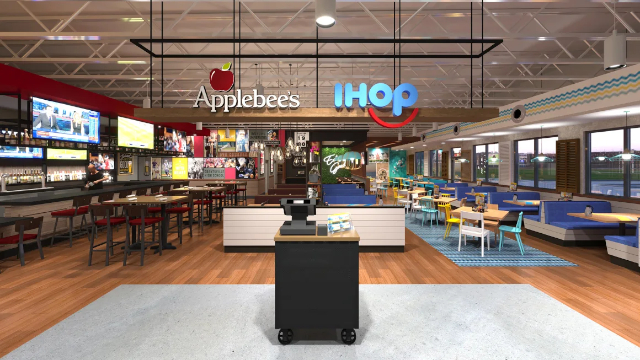New survival strategies are beginning to surface as second-tier Fast Food and Casual Dining joints struggle to survive in the rapidly changing Foodservice sphere. Dine-in resto brands are teaming-up to share space and resources…
It was probably a natural outgrowth of the growing concentration of smaller Fast Food and Casual restaurant brands under the ownership if foodservice-oriented holding companies. That trend start-ed back before the COVID Crisis, and continues to this day. Restaurant Brands International (RBI), for example, has quietly acquired brands including Tim Horton’s, Popeye’s, Burger King and Firehouse Subs in the past few years.
These brands don’t compete directly with one another. So they can operate in the same geographical areas, maximizing the reach of RBI brands to the broadest possible range of demographic segments and tastes in those markets. But they can also – and sometimes do – share some resources, and in-dulge in crossover promotions as well as engineering opportunities for other cooperative activities.
The prototype?
An early, prime example in the Fast Food world is Carl’s Jr. and Hardee’s. They’re owned by the same corpor-ation, but exploit different markets.
“The two burger chains started out as totally separate entities, one on the West Coast and one in the eastern U.S,” Mental Floss (MF) relates. “Carl’s Jr. is the elder of the two, founded as a Los Angeles hot dog stand in 1941 by Carl Karcher. […] Before long, burgers were the chain’s bestselling menu item, so Karcher decided to open a separate group of small, quick-service burger joints, dubbing them Carl’s Jr.”
“Wilbur Hardee opened his first restaurant in North Carolina in 1960,” MF continues. “Soon, Hardee’s became a familiar fast food sight in the Midwest and South. Hardee’s corporate strategy was to open restaurants in smaller towns that were not served by McDonald’s or Burger King. […]. By the early ‘90s, there were more than 2,500 Hardee’s locations, making it the country’s fourth-largest fast food chain.”
The corporation that runs Carl’s bought Hardee’s in 1997, quietly evolving the brand to look and feel similar to Carl’s. At first, the menu was kept pretty much he way Hardee’s fans loved it. But the Har-dee’s menu began to look more like Carl’s by the mid-2000s. And now, both stores look and feel very similar. Not quite fraternal twins… Plenty to share, but not identical, either.
More recently…
Holding company Inspire Brands has brought together a neat, tidy collection of popular resto brands including Arby’s, SONIC, Jimmy John’s, Buffalo Wild Wings, Dunkin Donuts and Baskin-Robbins. Their roster consists of non-competing brands whose menus are mutually complementary and also share a certain ‘cachet’…
Each is a leader in its niche. But none is directly involved in the higher-level – arguably less bou-tiquey – ‘burger mainstream’. Even SONIC bills itself as the last of America’s original ‘diners’…
RBI and Inspire are just 2 of a number of non-household names that are taking over smaller Fast Food and Casual restaurant brands as the big sector shakeout I’ve been predicting for years move ahead apace. And this appears to be a win-win solution to the conundrum smaller brands faced when they hit the COVID lockdown wall.
It’s provided a way for them to not only survive, but thrive in a market where the monster brands such as McDonald’s, Starbuck’s and Taco Bell are ‘going it alone. The latter are facing hard decisions about major business model and image changes associated with the Restaurant of the Future (RotF) revolution.
The next step…
The next logical step in the consolidation trend has emerged in a new cooperative effort by Apple-bee’s and IHOP to share dining room space and other resources under a single roof, opening combo locations.
Dine Brands – another little-known holding company – owns both Apple-bee’s and IHOP along with Fuzzy’s Taco Shops. The word ‘Dine’ in its name differentiates it from the other conglomerates we’ve looked at today, in as much as Dine’s restos are all focused on family, dine-in service.
The idea behind the Applebee’s-IHOP alliance, FoodBeast reports, is to offer, “a dual-themed space: one side with IHOP’s cozy, homestyle vibes and the other rocking Applebee’s signature sports bar atmosphere, complete with big-screen TVs showing various games.”
My take
I didn’t envision a two-tier Fast Food and Casual Dining restaurant marketplace when I first predicted the big sector shakeout a decade ago. But it makes sense. And it proves the adage, popularized by professor Ian Malcolm in the Jurassic Park films, that – when it comes down to a matter of sheer survival – ‘nature always finds a way’…
~ Maggie J.


